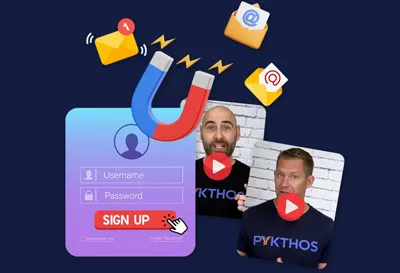
What Makes Successful Hypnotherapists Look So Put-Together? (Hint: It's Not Talent)
What Makes Successful Hypnotherapists Look So Put-Together? (Hint: It's Not Talent)

By Timothy September
Last week at 3 AM, one of our Mastermind members sent me a DM that hit me right in the feels:
"Timothy, I know this sounds ridiculous, but how do the successful practitioners make it all look so EASY? I'm drowning in emails, forgetting follow-ups, and my notes are scattered across three different apps. Meanwhile, Jessica from my certification class already has a wait list and an Instagram that looks like she has a whole team. I'm starting to think some people just have a natural talent for this business stuff that I'm missing."
First off—it was 3 AM. If you're sending business panic texts at 3 AM, I promise you're not alone. I've been there more times than I can count.
Second—this question gets to the heart of what's holding back so many talented hypnotherapists.
The big secret? The successful ones don't have more talent.
They have better systems.
The "Natural Talent" Myth That's Killing Your Confidence

We've all done it. Scrolled through another practitioner's polished website or watched their flawless client testimonial video and thought: "They must just have a knack for this that I don't have."
This type of thinking is called the "Magic Person Fallacy"—the belief that successful people possess some mystical quality you weren't born with.
Let me be crystal clear: There is no such thing as a naturally talented business owner.
What looks like "natural talent" is almost always just:
Consistent systems that run in the background
Clarity about what matters (and what doesn't)
Support from people who've been there before
One of our members in the Pykthos Mastermind, David, put it perfectly: "I used to think I just wasn't cut out for running a business. Now I realize I was just trying to keep everything in my head instead of building systems. No wonder I was drowning."
And here's the thing—the practitioners who seem most "put together" are often the ones who were initially the MOST overwhelmed.
They didn't succeed despite their struggles; they succeeded because their struggles forced them to find a better way.
What Top Performers Do Differently (That You Can Start Today)

After working with hundreds of hypnotherapists in the Pykthos Mastermind, we've noticed clear patterns that separate those who thrive from those who struggle.
Here are the five key differences:
1. They Operate From a Profit Process Map, Not Random Activity
Struggling practitioners wake up and ask: "What should I do today?"
Successful practitioners wake up already knowing exactly what moves the needle in their practice, because they've mapped their entire business process.
Using the Profit Process Map from our Pykthos Growth System, they can see exactly how a stranger becomes a lead, how a lead becomes a client, and how a client becomes a referral source.
This map is a nice visual, but more importantly, it's a decision-making tool that eliminates guesswork.
And when you actually track what’s happening on the map, you know what’s working and what’s not.
When Jessica (the one with the waitlist) joined our Mastermind, her first revelation was: "I had no idea my Instagram posts weren't actually bringing in clients until I mapped my process. I was spending hours on the wrong activities!"
After creating her Profit Process Map and starting to track the metrics she realized most of her clients came from physician referrals—so she doubled down there and created systems to nurture those relationships.
As the old saying goes, “What gets measured, gets managed.”
2. They Use Frameworks, Not Reinvention
Amateur practitioners try to figure everything out from scratch.
Professional practitioners use proven frameworks that have worked for others.
Inside the Mastermind, we teach the Perfect Client Snapshot (what others might call an "ideal client profile"). This framework helps you get crystal clear on exactly who you serve best.
When practitioners implement this framework, something magical happens: their marketing becomes effortless because they're speaking directly to someone specific rather than trying to appeal to everyone.
Mark, a hypnotherapist in our community, said: "Before the Perfect Client Snapshot, I spent hours agonizing over every social media post. Now I just ask myself, 'Would this help my avatar, Phil?' and the words flow naturally."
That clarity saves him 5-7 hours every week; hours he now spends with paying clients instead.
3. They Invest in the Right Tools, Then Master Them
The practitioners who struggle are usually using:
Free or bargain-basement tools that don't integrate with each other
Too many different tools (calendar here, website there, payments somewhere else)
Tools they haven't fully learned how to use
Meanwhile, the practitioners who look effortlessly professional have:
A single, integrated platform for their core business functions
Mastery of the few tools they use daily
Automation that handles repetitive tasks

While the most expensive setup may look nice, it's more about having the right setup for your specific practice.
In the Pykthos Mastermind, we discovered that most practitioners waste $100-300 monthly on disconnected tools they barely use, while missing the core functionalities that would save them hours daily.
That's why we include the Pykthos Platform for mastermind members. It has everything in one place—scheduling, client management, billing, and content delivery. Our members typically reduce their tech expenses by 30-50% while eliminating the integration headaches entirely.
As one member put it: "I used to spend Sunday nights connecting all my different apps with Zapier prayers. Now everything just works."
Zapier prayers. I love that phrase.
4. They Decide Once, Not Daily
The practitioners who seem effortlessly organized have figured out something crucial: decision fatigue is real, and it's killing your practice.
Every time you have to decide:
How to respond to a new client inquiry
What to charge for a service
How to follow up after a session
What content to post
How to handle a cancellation
...you're using up precious mental energy that should be reserved for your clients.
The solution? Decide once, then systemize it.
Inside the Mastermind, we guide practitioners to create their Brand Messaging Blueprint (what others might call a "core message canvas"). This becomes their single source of truth for all communications.
When a new inquiry comes in, they don't have to reinvent their response. When it's time to create content, they don't stare at a blank page.
They've already decided these things once, documented them, and now they just execute.
Lisa, a hypnotherapist focused on anxiety, told us: "I used to spend 20 minutes crafting each email response to new inquiries. Now I have templates for everything, and it takes me 2 minutes to personalize them. That alone saved me 5 hours last week."
5. They Have a Community, Not Just Clients
Here's the uncomfortable truth: isolation is professional poison for hypnotherapists.
The practitioners who seem to have it all together aren't figuring everything out alone in their office at midnight.
They have a community of peers who:
Share what's working in their practices
Provide feedback on new ideas
Offer support during inevitable setbacks
Celebrate wins (big and small)
Hold them accountable to their goals
This isn't just about feeling good. Anyone who’s ever been successful at what they do has a support group of like-minded peers.
Because it’s less about having friends and more about accelerating your growth through collective wisdom.
One of our Mastermind members, Terance, had been stuck for over a year with analysis paralysis. Within his first 90 days in our community, he implemented ideas from other members and built his first funnel, successfully created a customer journey using a bookmark, and accelerated his lead generation.
His reflection was powerful: "I realized I'd been reinventing the wheel when there were people willing to hand me their blueprints. My ego was costing me more hours a month than I want to admit. Having the right community really pays off."
Confidence Comes From Clarity, Not Charisma

Have you ever noticed how the most confident hypnotherapists aren't necessarily the most outgoing or charismatic?
That's because true professional confidence comes from clarity, not personality.
When you have:
Absolute clarity about who you serve (Perfect Client Snapshot)
Crystal clear messaging about how you help them (Brand Messaging Blueprint)
A documented process for turning strangers into clients (Profit Process Map)
Systems that run smoothly in the background (Pykthos Platform)
...you naturally exude confidence because you're not scrambling.
One of the quietest, most introverted members of our Mastermind recently shared this insight: "I used to think I needed to be more outgoing to succeed. Now I realize I just needed to be more organized. My systems speak for me, and that gives me the confidence to be myself."
Her practice is now fully booked with a 6-week waitlist, and she hasn't changed her personality one bit.
The Simple Backend Systems That Make You Look Like a Pro
Let's get practical.
What specific systems make the biggest difference in how professional your practice appears?
If you are like most hypnotists, you think you need everything under the sun to look and feel like a professional.
But in reality, there are only a few things you need to accomplish that.
Best of all, most, if not all of these systems can be automated; meaning you never have to worry about it once you first set it up.
Let’s talk about five easy-to-setup systems that create a seamlessly professional experience for your clients while making your life infinitely easier:
1. The New Client Onboarding Sequence
This automated system:
Sends a welcome email immediately after booking
Delivers intake forms with clear instructions
Provides pre-session preparation guidelines
Sends appointment reminders (24 hours and 1 hour before)
Includes a quick intro video from you explaining what to expect
When this system is in place, clients feel held and guided from the moment they book. They think: "Wow, this person runs a real practice."
Meanwhile, you're freed from manually sending all these communications.
2. The Session Follow-Up System
After each session, your system automatically:
Sends a personalized follow-up email
Delivers any reinforcement materials (like recorded hypnotic audio)
Schedules the next appointment if it's a package
Requests feedback at the optimal time
Triggers reminders for you to check in personally when appropriate
This creates the impression that you're thinking about each client constantly—when in reality, your system is handling most of the heavy lifting.
3. The Content Deployment Schedule
Professional practitioners don't create content in a panic when they realize they haven't posted in weeks.
Instead, they have a simple system that:
Batches content creation (usually monthly or quarterly)
Schedules deployment automatically
Repurposes content across multiple platforms
Tracks engagement to improve over time
The Pykthos Platform makes this easy with built-in content scheduling and management tools.
4. The Testimonial Requesting System
The practitioners who rise to the top aren’t technical wizards. They just have systems that help them them:
Easily request reviews or testimonials from customers
Professionally display the testimonials on their preferred website or funnel
Create a system that collects testimonials for future use
Track who’s left a testimonial and who hasn’t
When you have a system that can automatically solicit testimonials or reviews for your business, it’s like an extra employee is on stand-by, waiting to help you succeed.
5. The Deep Dive Analysis
This system doesn't just track your appointments—it tracks your impact:
How many people landed on your page
Of those, who booked a discovery call
How many discovery calls turned into paid sessions
After their session, who left a review
When you can see your success patterns clearly, your confidence soars and your marketing becomes evidence-based rather than aspirational.
One Mastermind member shared: "Once I started tracking my success rate with smoking cessation clients, I was able to make better choices for my business. I didn’t learn a mystical secret to running a business—I just had data to back up my claims."
Starting Where You Are (Even If That's Chaos)

If you're reading this in the middle of the night, surrounded by sticky notes and open browser tabs, feeling overwhelmed—I've been there.
The good news? You don't have to implement everything at once.
Inside the Mastermind, we guide practitioners through what we call the "Pykthos Growth System" approach:
Write down your current process, no matter how messy it is
Identify what your customers are buying, and anything else you want to sell them
Figure out who your customer really is
Learn how to talk to them
Map out the path your customers take to buy from you
For most practitioners, the first bottleneck is usually client acquisition.
That’s what the Perfect Client Snapshot and Brand Messaging Blueprint are for.
These are pivotal tools that transform how you view your client and how you talk to them.
And when you get it right, you'll see results within days, not months.
The Truth About "Overnight Success"
Jessica—the practitioner with the waitlist who prompted that 3 AM text—wasn't born knowing how to run a hypnotherapy practice.
She struggled like everyone else. But she made one crucial decision: she stopped trying to figure it all out alone.
When she joined the Pykthos Mastermind, she implemented the core systems we've outlined here. She mapped her process. She created her frameworks. She set up her automation.
And yes, now she has a waitlist and looks impressively put-together.
But it didn't happen overnight, and it certainly didn't happen because she has some magical talent gene that you're missing.
It happened because she followed a proven path and built systems that work while she sleeps.
You can do the same.
Your Next Steps Toward Systems-Based Success
If you're ready to stop drowning in the day-to-day chaos of your practice and start building systems that make you look (and feel) like the professional you truly are, here are three steps you can take today:
Step 1: Start Documenting
Even before you build fancy systems, start documenting everything you do in your practice:
How you respond to inquiries
What common questions you get asked
How clients get session assets (audios, contracts, etc)
What your follow-up process looks like
This documentation becomes the foundation for your systems.
Step 2: Map Your Current Process
Even if it's messy, map out how clients currently find you, work with you, and (hopefully) refer others to you.
This Profit Process Map will immediately reveal where you're losing potential clients and where you can improve the experience.
Step 3: Focus on One System at a Time
Don't try to fix everything at once. Pick the area causing you the most stress and build a simple system to address it.
If you're not sure where to start, we can help.
Inside the Pykthos Mastermind, we don't just tell you what systems to build—we give you the exact templates, tools, and support to build them quickly and effectively.
Our members get access to:
The Pykthos Platform with all the tools you need in one place
The Brand Messaging Blueprint to clarify your unique value
The Perfect Client Snapshot to understand who you're meant to serve
Weekly coaching calls where we tackle your specific challenges
A community of practitioners who understand the journey you're on
This is exactly the kind of transformation we help our members through. If building systems that make you look and feel confident sounds like exactly what you need right now, you'd probably love the support we provide in the Mastermind.
Remember: The practitioners who look like they have it all together aren't more talented than you. They've just built better systems.
And with the right guidance, you can too.
Timothy September
Co-Founder / Team Pykthos






